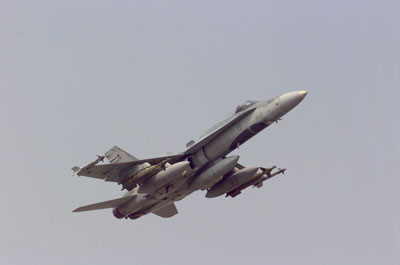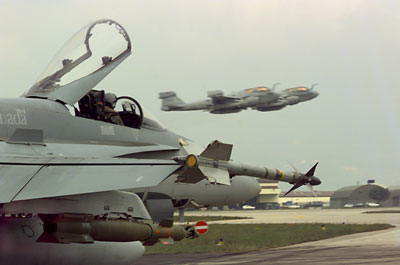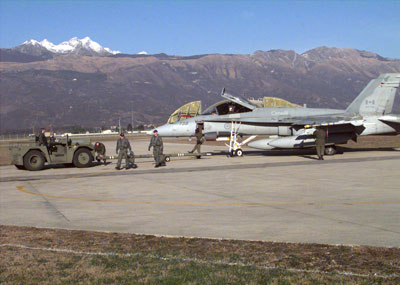 This information has been archived for reference or research purposes.
This information has been archived for reference or research purposes.
Archived Content
Information identified as archived on the Web is for reference, research or recordkeeping purposes. It has not been altered or updated after the date of archiving. Web pages that are archived on the Web are not subject to the Government of Canada Web Standards. As per the Communications Policy of the Government of Canada, you can request alternate formats on the "Contact Us" page.
Views and Opinions

DND Photo CKD99-2082-01 by Corporal Danielle Bernier
A CF-18 Hornet fighter aircraft from Task Force Aviano, the Balkan Rats, heads out on a combat mission, 1 June 1999.
The Kosovo Crisis: Toward a New Conception of Aerial Warfare
by Louis Hénault
For more information on accessing this file, please visit our help page.
Introduction
As a result of the successes during the First Gulf War, the strategic use of military aviation was highly popular in the 1990s. The intervention in Iraq confirmed that air power was a potentially decisive force, and, in the years following the conflict, the strategic use of this power became part of the official doctrine of Western air forces on how to conduct aerial warfare.
The NATO intervention in Kosovo in 1999, Operation Allied Force, reinforced this conception of conducting aerial warfare. However, the Kosovo conflict was so different from the First Gulf War that the popular aerial warfare approach was not suitable. Did Kosovo change the way we look at conducting aerial warfare?
This article will answer this question in the affirmative and will attempt to explain how the Kosovo crisis has changed our perspective. To accomplish this, it will start by tracing the evolution of the theory of aerial warfare, then it will demonstrate how Operation Allied Force has shaped the way we look at conducting aerial warfare.
The evolution of the theory of aerial warfare: where did the debate stand when the Kosovo crisis began?
Considered a pioneer of the theory of aerial warfare,1the Italian General Giulio Douhet helped introduce the concept of strategic aerial warfare. Basing his arguments upon the events of the First World War, he maintained that air power must play a key offensive role in warfare, and that the other services, such as the army and the navy, must play a defensive role. Rather than attacking enemy troops, he thought it was better to bomb urban centres in order to destroy the economy and to sap the enemy’s morale. According to his theory, the damage would eventually convince an enemy to surrender.
General Douhet’s approach influenced thinkers of the 1920s and 1930s. Among his most illustrious contemporaries, US Brigadier General William “Billy” Mitchell campaigned actively, sometimes generating the wrath of his superiors, for air power to play a key role in military affairs. Because of his activism, American military aviation made enormous strides during these years, and he had contributed significantly to the theory of air power by the eve of the Second World War.
The strategic aerial warfare advocated by Douhet and Mitchell significantly characterized the use of air power during Second World War. The atomic bombings of Hiroshima and Nagasaki in 1945, after which Japan surrendered, were a powerful demonstration of their conception of the strategic use of air power as a potentially decisive force.
Perhaps in reaction to the Japanese bombings, the theory of strategic aerial warfare developed very little from 1945 to the late 1980s.2 Although strategic bombing was extensively used in Korea and Vietnam, it lost much of its popularity thereafter. This was certainly the case in the US military, particularly in the 1980s. Influenced in part by the general perception of failure in Vietnam, US military leaders gradually lost confidence in the effectiveness of strategic bombing, so much so that the need to maintain an independent air force was seriously questioned.3
The First Gulf War changed this perception considerably. The success of strategic air power in Iraq, largely attributed to the role of US Colonel John Warden III in planning the air offensive, clearly showed that air power was again a potentially decisive force. Strategic aerial warfare had again become part of the official doctrine of Western air forces.4
The way in which Warden viewed the use of air power veritably revolutionized the way we view aerial warfare. Warden considered that, because of modern precision weapons, strategic aerial warfare must be used to politically paralyze the enemy. The strategy he advocated centres around a series of air strikes that can lead to the adversary’s strategic paralysis.5 This theory dominated the debate on the use of air power in the 1990s.
How did the Kosovo crisis call the previously advocated approach into question?
While Warden’s approach certainly influenced the NATO intervention in Kosovo, it was not well suited to the reality of this conflict. According to the official doctrine of Western air forces, which was based upon the way aerial warfare had been conducted during the First Gulf War, massive air strikes had to be launched simultaneously against multiple strategic targets in order to inflict as much damage as possible.
Some significant realities rendered this approach inappropriate. It was not suitable to make optimal use of power in Kosovo for two main reasons: first, there was strong international opposition to the NATO intervention, and secondly, Warden’s approach was not well suited to the nature of the conflict.
International opposition to the NATO intervention was palpable. In many European NATO member countries, the majority of the population did not favour the use of air strikes in Serbia.6 Some governments, particularly those of Russia and China, had also expressed their opposition to such an intervention.
In this situation, it would have been difficult to justify a high-intensity intervention such as the one that had taken place in Iraq. As the Norwegian scholar and air force officer Dag Henriksen explains, politicians and diplomats clearly understood that Warden’s approach, consisting of massive parallel attacks against the political and military leadership, would inevitably weaken a number of European governments and undermine cohesion within NATO. For these reasons, NATO had to opt for a more moderate approach.7
The nature of the conflict was also an important aspect to consider. What was the expected objective of this intervention? Sending Serbian troops into Kosovo had been a disaster: the media had reported cases of ethnic cleansing of the Albanian minority. Faced with this situation, NATO decided to intervene.
It was not a matter of toppling a government, or even of completely paralyzing it. The Kosovo crisis did not require a high-intensity intervention, as did the First Gulf War. Moreover, such an approach would have been excessive, because the stability of the former Yugoslavia was at stake. It was a matter of using force in a diplomatic context to settle an ethnic conflict before it took on larger proportions. In short, NATO had to find a way to use as little force as possible to force Milošević’s Serbian government to yield and withdraw its troops from Kosovan territory.

DND Photo CKD99-2029-01 by Corporal Danielle Bernier
Canopy open to the warm Mediterranean sun, this CF-18 pilot awaits taxi clearance at NATO Air Base Aviano while two United States Marine Corps Prowler aircraft take off on a combat sortie, 24 April 1999.
How did Operation Allied Force change the face of aerial warfare?
Faced with these important realities, NATO opted for a much more moderate approach: targeted air strikes. As it was difficult to predict with certainty what would make the Serbian government capitulate, the intensity of the operation increased progressively so as to limit the force used to accomplish the intervention’s main objective, the withdrawal of Serbian troops. Often described as “gradual,” the strategic air strike campaign consisted of three phases.
The first phase began on 24 March 1999. Its objective was to destroy the integrated air defence system. NATO forces met with very little resistance from Serbia, but it soon became clear that the air strikes would not yield the desired result, since Milošević was not budging with regard to the Serbian troops in Kosovo.
After just a few days of air strikes, NATO moved on to the second phase of the offensive much sooner than planned. This phase consisted of strikes against military targets south of the 44th Parallel, which divides the former Yugoslavia in two, far from Belgrade.
At the beginning of the fourth week of air strikes, NATO proceeded to the final phase of its campaign. In the face of Milošević’s constant refusal to withdraw his troops from Kosovo, NATO began bombing strategic targets—including Belgrade, the capital of Serbia—north of the 44th Parallel. From that point on, the targets included what some observers described as the four pillars of Milošević’s power: the political machine, the media, the security forces, and the economic system.8
These attacks convinced Serbia to withdraw its troops from Kosovo. The damage that the bombings caused to the Serbian economy, particularly the destruction of the electrical system, appeared to have overcome Milošević’s obstinacy.9 On 9 June 1999, he agreed to bring his troops home, and NATO ceased its air strikes.
Despite the success of the air strike campaign, NATO’s approach was criticized. Some US generals even insinuated that Belgrade should have been heavily targeted as of the first day of the intervention.10 As was stated earlier, such an approach would have been inappropriate. Important political realities had to be taken into consideration; disregarding these realities could have had serious international repercussions upon the result of the offensive.
To some extent, Operation Allied Force appears to have changed our point of view with respect to the optimal use of air power. NATO’s approach has helped advance the debate on conducting aerial warfare on two main fronts.
First, the use of air power during the intervention in Kosovo confirmed that strategic aerial warfare is a potentially decisive power. As defence analyst Darko Ribnikar maintains, “One of the main lessons of the Kosovo war concerns the effectiveness of air power and the possibility of conducting warfare without engaging troops on the ground” [translation].11 The success of the intervention is all the more remarkable because there were no fatalities on the NATO side.12
Secondly, this intervention clearly showed that Warden’s method could not apply to all conflicts. As stated above, high-intensity strategic aerial warfare, of the type advocated following the First Gulf War, was not appropriate for the situation in Kosovo. The Kosovo example will very likely prove helpful in future interventions in which military air power is used.
Conclusion
As this article has attempted to demonstrate, the Kosovo crisis has helped change our conception of aerial warfare. The NATO intervention changed the theory of strategic aerial warfare of the 1990s. Kosovo proved to be an important point in terms of military aviation: the use of air power must sometimes be moderated and adjusted according to the conflict. It goes without saying that NATO’s approach in Kosovo cannot be applied for all future conflicts. However, the example of this intervention will undoubtedly remain an important step in the development of the theory of aerial warfare.

DND Photo AVD-00-018-003a
![]()
Captain Louis Hénault is currently an air combat systems officer at 413 Transport and Rescue Squadron in Greenwood, Nova Scotia. He holds a master’s degree in public policy from the Australian National University and an undergraduate degree in business administration from Laval University.
NOTES
- Patrick Facon, “Théorie de la guerre aérienne,” in Thierry de Montbrien and Jean Klein (eds.), Dictionnaire de stratégie, (Paris: Quadrige, 2006), p. 288.
- Ibid., p. 289.
- Dag Henriksen, NATO’s Gamble: Combining Diplomacy and Airpower in the Kosovo Crisis 1998–1999, (Annapolis, MD: Naval Institute Press, 2007), p. 39.
- Benjamin S. Lambeth, The Transformation of American Air Power, (London: Cornell University Press, 2000), pp. 263–274.
- Facon, p. 289.
- Henriksen, p. 61.
- Ibid., p. 61.
- Lambeth, p. 187.
- Ibid., pp. 188–189.
- Henriksen, p. 38.
- Darko Ribnikar, “Les leçons de la campagne du Kosovo,” Revue internationale et stratégique, 51, 2003/3: p. 131.
- Michael Ignatieff, Virtual War: Kosovo and Beyond, (London: Penguin Group, 2000), p. 161.






